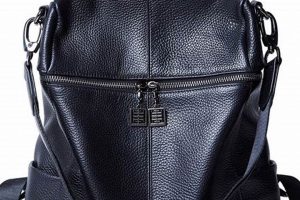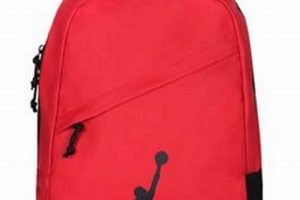A specialized bag designed to deter theft through various security features. These features commonly include lockable zippers, hidden compartments, slash-resistant materials, and RFID-blocking pockets. An example would be a travel bag with reinforced straps and a combination lock securing the main compartment.
The increasing prevalence of petty crime, especially in crowded urban environments and while traveling, underscores the importance of safeguarding personal belongings. The benefits extend beyond simple protection to providing peace of mind, allowing the carrier to focus on their surroundings without constant worry. The concept evolved from simple reinforced bags to incorporate technological solutions designed to thwart sophisticated theft attempts.
The subsequent discussion will delve into specific anti-theft technologies employed, materials utilized in their construction, selection criteria for choosing an appropriate model, and practical usage tips for maximizing their protective capabilities.
Anti-Theft Backpack Usage
This section provides crucial information for maximizing the protective capabilities of specialized bags designed to deter theft. Following these guidelines will enhance security and provide greater peace of mind.
Tip 1: Secure Zippers: Engage locking mechanisms or clips, if present, on zippers to prevent unauthorized access. Many models feature integrated locks or require the user to loop the zipper pulls through a central ring.
Tip 2: Utilize Hidden Compartments: Store valuables such as wallets, passports, and electronic devices in concealed pockets. These compartments are designed to be difficult to locate and access quickly.
Tip 3: Employ the Slash-Resistant Features: Be aware of panels or straps reinforced with wire mesh, preventing thieves from cutting into the bag to steal its contents. Place items of higher value behind these reinforced areas.
Tip 4: Be Mindful of RFID Blocking: Store credit cards and passports with embedded RFID chips within designated RFID-blocking pockets. This prevents electronic skimming of personal data.
Tip 5: Consider Bag Placement: When in crowded areas, wear the bag on one’s front or side, keeping it within view. In less crowded settings, ensure the bag remains within close proximity and awareness.
Tip 6: Register Your Product: Register the product with the manufacturer, if possible. This can aid in recovery if the product is lost or stolen and contains identifying information.
Tip 7: Customize Security: Add additional security measures such as small padlocks or cable ties to zippers for increased deterrence, especially in high-risk environments.
By incorporating these practices into daily routines, the user can significantly increase the security afforded by their specialized bag and deter potential theft attempts.
The concluding section will summarize the advantages of using specialized bags to deter theft and provide a final assessment of their overall effectiveness.
1. Lockable zippers
Lockable zippers represent a fundamental security feature commonly integrated into bags designed to deter theft. The cause-and-effect relationship is straightforward: unsecured zippers offer easy access, while lockable zippers impede unauthorized opening. Their presence is vital as the main compartment zipper is often the initial point of entry for theft. For instance, a bag with flimsy, easily opened zippers provides minimal protection, whereas a bag with robust, lockable zippers significantly raises the barrier to entry. The practical significance lies in preventing opportunistic theft in crowded areas or during travel.
The effectiveness of lockable zippers depends on several factors, including the quality of the locking mechanism and the overall construction of the bag. A poorly designed lock can be easily bypassed, negating its intended purpose. Real-world examples demonstrate this; a simple combination lock on a sturdy zipper can deter casual theft, while a complex lock on a weak zipper offers a false sense of security. Some bags utilize double zippers that can be interlocked, requiring more deliberate action to open. In essence, lockable zippers are most effective when coupled with other anti-theft measures.
In summary, lockable zippers are a key component in bag security. Their value lies in their ability to deter opportunistic theft and increase the time and effort required to access the contents. However, their effectiveness depends on their quality and integration with other security features. Understanding this relationship is crucial for selecting a bag that genuinely offers enhanced protection against theft and linking to the broader theme.
2. Slash-resistant material
Slash-resistant material forms a critical line of defense in specialized bags designed to deter theft. The inclusion of such materials mitigates the risk of thieves cutting into the bag to access its contents, particularly in crowded or high-risk environments. This feature directly addresses a common method of theft and contributes significantly to the overall security of the bag.
- Material Composition
Typically, slash-resistant materials involve a combination of high-strength fibers like UHMWPE (Ultra-High Molecular Weight Polyethylene), Kevlar, or fiberglass intricately woven into the fabric of the bag. These materials possess exceptional tensile strength, resisting cutting forces. For instance, a bag with a single layer of standard nylon might be easily cut open, whereas a bag reinforced with UHMWPE fibers would require significant effort and specialized tools to penetrate.
- Strategic Placement
The strategic placement of slash-resistant materials is essential. Often, these materials are integrated into the front, sides, and bottom of the bag areas most susceptible to slashing. Some designs incorporate slash-resistant straps as well, preventing thieves from cutting the straps and running off with the entire bag. A bag lacking strategically placed reinforcement is vulnerable, even if some sections contain resistant material.
- Concealment and Integration
The effectiveness of slash-resistant materials also depends on their seamless integration into the bag’s design. Ideally, the material should be discreetly concealed between the outer layer and the lining, preventing visual detection and discouraging potential thieves. If the slash-resistant material is visibly obvious, it may deter some thieves but also draw unwanted attention to the bag.
- Durability and Maintenance
Slash-resistant materials must maintain their integrity over time and with regular use. High-quality materials are resistant to wear, tear, and environmental degradation. However, excessive abrasion or exposure to harsh chemicals can compromise their effectiveness. Regular inspection and proper care are essential to ensure the continued protective capabilities of the bag.
In conclusion, the presence of slash-resistant materials is a significant factor in assessing the protective value of bags designed to deter theft. The type of material, its strategic placement, its integration into the design, and its long-term durability all contribute to its overall effectiveness. A well-designed bag incorporates these aspects to provide a robust defense against slashing attempts, thereby enhancing the security of the carrier’s belongings and furthering the objectives of bags designed to deter theft.
3. Hidden compartments
Hidden compartments are a key design element frequently integrated into bags designed to deter theft. Their presence serves to conceal valuables from opportunistic thieves, adding a layer of security beyond readily visible storage areas. These compartments function by being difficult to locate quickly or access without specific knowledge of their presence.
- Concealment Techniques
Concealment techniques vary widely, ranging from pockets integrated into the lining to false bottoms or backs. Some compartments are disguised as part of the bag’s structure, requiring specific manipulation to access. An example is a compartment located behind padding on the back of the bag, accessible only by unfastening a hidden zipper or Velcro closure. The effectiveness depends on the ingenuity of the design and the casual observer’s inability to detect the compartment’s existence.
- Accessibility and Discretion
Accessibility must be balanced with discretion. A compartment that is too difficult to access negates its practical use, while one that is too easily discovered compromises its security. Ideally, the user should be able to access the compartment swiftly in a safe environment but remain confident that it will not be discovered during casual inspection. This often involves utilizing zippers or closures that blend seamlessly with the bag’s design.
- Placement and Risk Mitigation
Placement of compartments is strategic, typically in areas less likely to be searched during a cursory examination. Examples include the bottom of the bag, behind water bottle holders, or within the shoulder straps. This placement strategy mitigates the risk of theft by placing valuables out of immediate reach and sight, requiring a more thorough and time-consuming search. Compartments near the body, such as those in the back panel, offer increased security.
- Limitations and Considerations
While effective, hidden compartments are not foolproof. Determined thieves may still discover them with sufficient time and effort. Over-reliance on hidden compartments without employing other security measures, such as lockable zippers or slash-resistant materials, can create a false sense of security. Additionally, airport security procedures may require opening all compartments, negating their concealment benefits in certain situations.
The incorporation of hidden compartments contributes significantly to the overall security of bags designed to deter theft. Their effectiveness depends on thoughtful design, strategic placement, and a user’s awareness of their limitations. When combined with other security features, these compartments provide a valuable layer of protection against opportunistic theft, enhancing the safety and peace of mind for the carrier.
4. RFID protection
Radio-Frequency Identification (RFID) protection, when integrated into bags designed to deter theft, safeguards sensitive data stored on RFID chips embedded in items such as credit cards, passports, and identification cards. The cause-and-effect relationship is such that without RFID protection, these chips are vulnerable to electronic skimming, enabling thieves to wirelessly steal personal information. Therefore, RFID protection serves as a crucial component in bags to deter theft, preventing a form of digital pickpocketing.
The implementation of RFID protection typically involves incorporating a metallic fabric or lining into designated pockets within the bag. This material acts as a Faraday cage, blocking electromagnetic fields and preventing unauthorized access to the RFID chips. For instance, a passport stored in an unprotected pocket is susceptible to skimming, potentially leading to identity theft. Conversely, storing the same passport in an RFID-protected pocket renders the RFID chip undetectable to scanners, mitigating the risk. The practical application of this understanding lies in the user’s ability to make informed decisions about where to store sensitive items within the bag.
While RFID protection offers a significant layer of security, it is not without limitations. It primarily addresses the risk of electronic skimming and does not protect against other forms of theft, such as physical pickpocketing or slashing. The effectiveness of RFID-blocking technology can also vary depending on the quality of the shielding material and the frequency range of the RFID chip. The ongoing challenge involves developing more robust and versatile RFID protection that can adapt to evolving skimming technologies, linking back to the broader need for holistic security measures in bags designed to deter theft.
5. Durable construction
Durable construction is paramount to the effectiveness of bags designed to deter theft, serving as the foundational element upon which other security features depend. Without robust construction, even the most sophisticated anti-theft mechanisms become vulnerable. Durability ensures the bag can withstand attempted tampering, extending its lifespan and preserving its protective capabilities.
- Material Integrity
The selection of high-quality materials, such as reinforced nylon, canvas, or specialized polymers, directly impacts the bag’s resistance to wear, tear, and cutting. For example, a bag constructed from standard polyester may be easily compromised, while one made from ballistic nylon offers significantly greater resistance to abrasion and slashing. This material integrity is critical for preventing thieves from quickly accessing the bag’s contents through force.
- Reinforced Seams and Stitching
The strength of seams and stitching is equally important. Weak seams represent a point of vulnerability that thieves can exploit. Reinforced stitching, often using high-tensile-strength thread, ensures that the bag’s components remain securely connected, even under stress. An example would be a bag with double-stitched seams at stress points, such as where the straps attach to the main body, enhancing its ability to withstand forceful handling.
- Zipper Quality and Reinforcement
Zippers are a common target for theft attempts. Durable construction necessitates the use of high-quality zippers, often made from metal or reinforced polymer, that are resistant to forced opening or breakage. Furthermore, reinforcing the area around the zipper with additional fabric or stitching prevents thieves from tearing the zipper away from the bag. A bag with flimsy plastic zippers offers minimal protection, while one with robust metal zippers and reinforced construction significantly deters tampering.
- Component Integration and Design
The overall design and integration of components contribute to the bag’s durability. A well-designed bag distributes weight evenly, reducing stress on individual parts and prolonging its lifespan. Integrating anti-theft features, such as slash-resistant panels, seamlessly into the bag’s structure enhances both security and durability. A poorly designed bag may exhibit weak points that compromise its overall integrity, regardless of the quality of individual components.
These facets of durable construction collectively contribute to the overall protective value of bags designed to deter theft. A robust and well-built bag not only withstands attempted tampering but also provides a secure platform for other anti-theft features to function effectively, ensuring the long-term protection of the carrier’s belongings. The relationship between durable construction and anti-theft effectiveness is inseparable, underscoring its significance in the selection and evaluation of such bags.
6. Discreet design
Discreet design constitutes a significant, though often understated, aspect of specialized bags designed to deter theft. The underlying premise is that a bag which does not overtly advertise its valuable contents is less likely to attract the attention of potential thieves. This approach contrasts with bags that, through conspicuous branding or styling, may inadvertently signal the presence of valuable electronics or other desirable items. A causal relationship exists: overt display increases the likelihood of targeting, whereas unobtrusive design reduces it. The importance of discreet design lies in its preventative nature, acting as a first line of defense against opportunistic theft.
Real-life examples underscore this point. Consider two individuals traveling in a crowded urban area. One carries a brightly colored bag emblazoned with the logo of an expensive electronics brand. The other carries a plain, unbranded bag of similar size and function. The former is statistically more likely to be targeted by a thief seeking electronics. Conversely, a bag that blends seamlessly into its surroundings and does not draw undue attention provides a degree of implicit security. Practical application involves selecting bags in neutral colors, avoiding prominent logos, and opting for designs that prioritize functionality over ostentation. For instance, a bag that resembles a typical student backpack, even if equipped with advanced security features, is less likely to be targeted than one that resembles a camera bag or a laptop bag.
Challenges remain in balancing discreet design with practical needs. A bag must be functional and comfortable, not merely inconspicuous. Overly simplistic designs may lack essential features or compromise user experience. Furthermore, a skilled thief may still identify a valuable target regardless of the bag’s appearance. Despite these limitations, discreet design remains a valuable component of a comprehensive anti-theft strategy, contributing to the overall effectiveness of specialized bags designed to deter theft and linking back to the broader theme of preventative security measures.
7. Adjustable straps
Adjustable straps, while seemingly a basic feature, play a critical role in the overall security and functionality of bags designed to deter theft. Proper adjustment contributes to comfort, weight distribution, and, importantly, the bag’s resistance to unauthorized removal. Therefore, the design and adjustability of straps are significant considerations when evaluating a bag designed to deter theft.
- Secure Fit and Body Contact
Adjustable straps allow the user to achieve a snug and secure fit, keeping the bag close to the body. This proximity makes it more difficult for thieves to access external pockets or attempt to remove the bag unnoticed. A loosely fitted bag presents an easier target, whereas a properly adjusted bag remains more secure. An example would be a bag with shoulder straps adjusted to minimize slack, preventing a thief from easily slipping it off the wearer’s shoulder.
- Weight Distribution and Balance
Adjustable straps enable optimal weight distribution across the wearer’s shoulders and back. Even weight distribution enhances comfort, reduces fatigue, and improves balance. This is relevant to security as an unbalanced bag is more cumbersome to carry, increasing vulnerability. For instance, a bag with adjustable sternum straps helps to stabilize the load, preventing it from shifting and making it more difficult for a thief to snatch.
- Tamper Resistance and Security Features
Some bags designed to deter theft incorporate security features directly into the straps, such as slash-resistant materials or locking mechanisms. Adjustable straps made with internal steel cables deter cutting, while straps with integrated locks prevent quick detachment. Adjustable straps, combined with these measures, contribute to the bags security of contents from potential theft.
- Comfort and Mobility
Adjustable straps improve comfort and enhance mobility. Improved comfort and mobility improve situational awareness. A bag with unyielding or poorly designed straps can cause discomfort. This discomfort contributes to the individual to pay less attention to their surroundings. This becomes an opportune situation for thieves to snatch valuables.
The adjustability of straps is therefore integral to the security, comfort, and overall effectiveness of bags designed to deter theft. Proper adjustment enhances security by keeping the bag close to the body and improving balance, while also enabling the integration of security features directly into the straps themselves. These factors collectively contribute to a more secure and user-friendly experience, reinforcing the importance of adjustable straps in bags designed to deter theft.
Frequently Asked Questions
This section addresses common inquiries regarding backpacks designed to deter theft, providing concise and factual answers to assist in making informed decisions.
Question 1: What constitutes an “anti-theft” backpack?
An “anti-theft” backpack incorporates security features designed to deter unauthorized access and protect valuables from theft. Common features include lockable zippers, slash-resistant materials, hidden compartments, and RFID-blocking technology.
Question 2: How effective are slash-resistant materials in preventing theft?
Slash-resistant materials, typically composed of high-strength fibers like UHMWPE or Kevlar, significantly reduce the risk of thieves cutting into the bag to access its contents. However, their effectiveness depends on the quality and coverage of the material.
Question 3: Does RFID-blocking technology guarantee complete protection against electronic theft?
RFID-blocking technology provides a significant barrier against electronic skimming of RFID chips. Complete protection is not guaranteed, as the effectiveness depends on the shielding material’s quality and the scanner’s power. It is crucial to ensure all RFID-enabled cards are placed inside designated pockets for optimal protection.
Question 4: Are anti-theft backpacks waterproof?
Water resistance varies depending on the specific model. Some anti-theft backpacks utilize water-resistant materials or include rain covers to protect contents from moisture. Confirm the bag’s water resistance rating before exposure to wet conditions.
Question 5: Can anti-theft backpacks prevent all forms of theft?
Anti-theft backpacks are designed to deter common theft methods. However, no bag can guarantee complete protection against all forms of theft. Vigilance and awareness of one’s surroundings remain crucial.
Question 6: Are anti-theft backpacks suitable for air travel?
Most anti-theft backpacks meet standard carry-on size requirements. Check with the airline regarding specific size and weight restrictions. Certain features, such as lockable zippers, may require TSA inspection during security checks.
Anti-theft backpacks offer a valuable layer of security when properly selected and used. Consideration of individual needs and risk factors is recommended when choosing an appropriate model.
The concluding section will delve into selecting the best type for you and summarize the discussion.
Conclusion
The preceding discussion has examined the multifaceted nature of the backpack with anti theft. This investigation covered fundamental design elements, ranging from material composition and construction techniques to specialized security features such as RFID protection and hidden compartments. The interplay between these elements dictates the overall protective capability of the apparatus.
The acquisition of a backpack with anti theft is a deliberate action aimed at mitigating the risk of property loss. While not an absolute guarantee against theft, such a bag significantly elevates the barrier to entry for potential thieves and provides a degree of reassurance. Prospective purchasers are encouraged to weigh their individual security requirements and situational risk factors to inform their selection process. Continued vigilance and adherence to sound security practices remain paramount, regardless of the protective measures employed.







